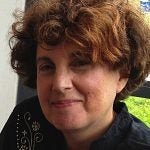The future is uncertain in nature-based exhibit at the New Jersey State Museum
Jim Toia: From Here to Uncertainty, on view at the New Jersey State Museum September 26 through January 3, 2016, includes an outdoor installation, “Entropic Flows,” made from a 100-foot log that tapers at both ends. “In the process of their entropic life, logs will fall apart over time and do what wood does,” says Toia. “In the end, I may let it go back into the ground. That’s the beauty of these things, they can morph and go back to the earth when ready.”
In the “Hall of Wonders” visitors will be encouraged to match the museum’s natural history holdings with Toia’s drawings and sculptural works created over the past 15 years and which include mushroom spores, jellyfish and spider webs, among other natural materials.
“Futurepast,” the fine arts gallery installation, is made up of a 13-foot hollow log that will house the cylindrical-shaped saltwater aquarium holding jellyfish. So how is the future past? “It’s a rudimentary cycle,” says Toia. “We’ve got water, sea life, and things that represent terrestrial life. The hollow log has been deteriorating over years, fueling the forest floor with nutrients. The water evaporates off the ocean surface, carried by clouds in the atmosphere, drains into the landscape and back into the rivers and sea, creating a cycle of nutrition and environmental balance.”
As an explorer, Toia collects ephemera that finds its way into his artwork. He lines his shelves with turtle shells, mushroom logs and other beautiful and fascinating objects. Visiting friends describe the home he shares with his wife, Angela Adams, a contemporary pop singer and registered nurse, as “the natural history museum of Jim Toia.”
“He uses natural materials the way other artists employ pencils, clay or paint,” says Fine Art Curator Margaret O’Reilly. “He has learned to manipulate the materials, but he also accepts the uncertainty that using them brings, creating aesthetically beautiful works which allow us to explore the symbiotic relationship between man and nature.”
Toia’s interest in mushrooms began in high school when he was taking public speaking and needed a subject. There was a mushroom outside the door of the building where he was to give the talk. “The amanita is fairly poisonous and can kill you or make you hallucinate in a very unpleasant way, but visually it’s enticing and beautiful and scary. Mushrooms are fascinating, ancient species, they’re their own kingdom, closer to animals than plants, and come in a wide variety of forms and do a wide variety of things, from breaking down things like dead trees to becoming nutrition for everything else. It’s how nature fuels itself. My initial interest, as I started working with nature in the art making process, I wanted to investigate mushrooms more. There are bracket mushrooms you can carve and paint and hang on a wall. There are fleshy chanterelles and oysters that eject spore into the atmosphere to propagate. You can capture the spores on paper for spore drawings. Inky cap mushrooms don’t eject spore, they just turn into a liquid that forms an ink that can be carried away by an animal.”
On occasion, Toia will even eat mushrooms. “Only if I’m absolutely sure of the identification.”
Toia makes his home in Califon, New Jersey’s hills because it’s both a refuge from and has proximity to the center of the contemporary art world. He calls the space he built in 2000 in Califon’s Long Valley his dream studio, at 45-by-25 feet, with a 35-foot peak and loft space in the top. “It gives me room to make large scale work, and work on an intimate scale on the second floor,” he says from his office at Lafayette College, where he teaches art full time and is the founding director of a community arts program for high school classes in the area.
From Lafayette, it’s a 35-minute commute back to the hills of New Jersey, a region that is mostly wooded, bisected by rivers and streams and surrounded by farmland. Toia is happiest in the natural world. “The woods of my home town have an infinite amount of information and offerings. I like to find natural spaces with no human interaction.”
The artist began fishing and splashing in rivers and streams in his boyhood in Summit. His parents were supportive of his art making, but Toia lost his mother was he was 17 so she never got to see him pursue it. An artist herself, “she left behind 20 paintings, which I cherish,” he says.
At Bard College, Toia began to take art making seriously. “There were more acres than students and a large fresh water estuary. I found myself drawn to the Hudson and wooded fields – it was a constant source of beauty and wonder. I’d jump in a canoe or walk the beautiful fields.”
Jim Toia will present a free lunchtime gallery walk through the exhibition on Friday, November 13, beginning at 12:10 pm. A virtual catalogue to accompany the exhibition will beginning at 12:10 pm. A virtual catalogue to accompany the exhibition will be available at www.statemuseum.nj.gov.
__________________________________________________
The Artful Blogger is written by Ilene Dube and offers a look inside the art world of the greater Princeton area. Ilene Dube is an award-winning arts writer and editor, as well as an artist, curator and activist for the arts.
WHYY is your source for fact-based, in-depth journalism and information. As a nonprofit organization, we rely on financial support from readers like you. Please give today.








